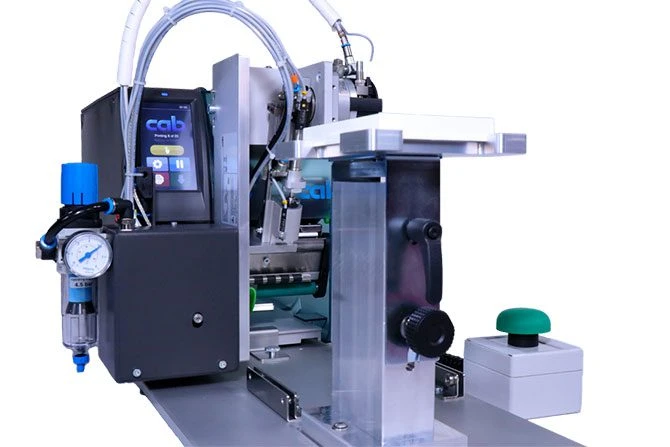The modular flexibility of the cab SQUIX benchtop label printer is one of the most significant advantages of using this model in your laboratory. Whether you are looking to improve accuracy, increase throughput, or simply make your labeling process more efficient—adding an accessory to your cab SQUIX printer can make a considerable difference. For example, the S3200 applicator for flat surfaces can be used to provide a fast, accurate, low cost solution for microplate labeling. Historically, most automatic microplate label applicators have required significant capital investment. The SQUIX S3200 solution provides an opportunity to upgrade with much less commitment.
S3200 SQUIX applicator breakdown
The cab S3200 applicator first requires the peel-off version of the SQUIX thermal transfer label printer. The peel function of the printer presents the label to the applicator pad. The applicator arm rotates up to the proper labeling position and accurately applies the label using the short stroke cylinder. An approximate calculation by cab states that this system can apply 20 labels per minute.
There are two types of applicator pads available with the S3200—which are manufactured to fit the size of the label. Both tamp pads and blow pads can be used to apply labels while the product is at rest, however only blow pads can apply labels to products in motion.
So, while both applicator pads can apply labels with precision and accuracy, the blow pad can help integrate your labeling process to existing automation along your production lines.
The S3200 can be used with most versions of the SQUIX including the SQUIX 2, 4, 4M, 4.3, and 4.3M—but is not compatible with the SQUIX 6.3.
Utilizing the S3200 applicator for microplate labeling
Between the quality and power of the SQUIX and the consistent accuracy of the S3200—this system offers a strong solution for microplate labeling. Due to the size and shape of microplates, particularly the limited height, applying labels to this type of labware can be especially tedious—resulting in extremely tight placement tolerances that are difficult to achieve with manual labeling.
Qualifying the proper label to fit your labware, environment, and chosen applicator can often be tricky. However, in the case of the SQUIX/S3200 system there are standard label options available which have been pre-approved for fast and easy implementation. These labels have the correct overall outer diameter, and also the appropriate core size for labels and ribbon to suit the SQUIX. Pairing these labels with appropriate thermal ribbon can tolerate temps down to -80C and would be chemically resistant to common lab solvents like DMSO, ethanol, ethyl acetate, methanol, and methylene chloride.
This system can be implemented quickly, without any need for expert installation, and is relatively low in cost compared to alternative solutions. It is best suited for low volume, high mix needs—or as a supplement to a large scale labeling strategy.
How much does the S3200 applicator cost?
The unit price for the SQUIX printer paired with the S3200 applicator is less than $15,000—customized plate labelers, or those designed for steady high volume use, start around $28,000. When considering an investment in label automation it is important to consider your goals and existing resources. Allocating time and manpower to applying labels can often cost you more over time as compared to the initial investment of automation—this is especially true now with the SQUIX/S3200.
Additionally, the value associated with integrating your labeling strategy with existing processes, improving accuracy, and increasing throughput may well tip the balance towards automation.
Automating processes is a proven way to reduce hassle and increase performance. No matter your goals, investing in an automation strategy can aid you in reaching them—it’s mostly a matter of finding the right fit.

